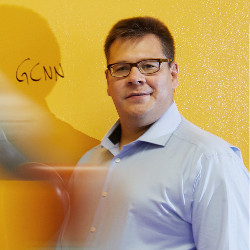
NAME
Arquimedes Canedo
BACKGROUND
Born and raised in Mexico, moved to Tokyo for graduate school, currently in Princeton, NJ
CURRENT JOB TITLE/EMPLOYER
Principal Key Expert Scientist, Siemens Corporate Technology
EDUCATION
Ph.D. Computer Science, University of Electro-Communications, Tokyo, Japan
A friend’s birthday barbecue is coming up in a few days and we decide to surprise our friend with a new grill. Online, a manufacturer’s website allows us to customize the grill. Unknown to us, the design space consists of billions of grills and we create a one-of-a-kind design that has never been produced before. Designing, procuring, producing, and delivering a unique product in a short time, at an affordable price, with minimal human intervention, requires complex interactions across software-hardware, systems, and time scales. This process, known as lot size one production, is only possible through the use of autonomous production systems.
Manufacturing is a cornerstone of a country’s innovation pipeline and many companies are reshoring to keep manufacturing and R&D as close as possible. While most people think manufacturing is low-tech and boring, I must disagree! The extreme complexity in manufacturing demands high-tech knowledge at all job levels. For instance, just think of a modern car with 30,000 parts and 100 million lines of code. Every part—down to the screws—is intricate and has been through a logistical maze. As a computer scientist, this complexity is why I find a career in manufacturing so rewarding.
Even simple products like our grill are designed and tested digitally using design automation and simulation tools. It takes years of experience to become a good designer. This is why automation is so important. Using machine learning, I’m able to reduce the time required for designing products from months to mere hours as well as free up time for the engineers, allowing them to focus on design in terms of functions, behaviors, and structures instead.
Imagine this: Our new grill is born in a factory that produces hundreds of one-of-a-kind grills, motorcycles, and other products. Autonomous unmanned vehicles are transporting parts and tools from storage to work cells; dozens of robots are working on different parts and assembling products; and new processes are being invented and implemented on-the-fly. This is the vision for general-purpose automation. In pure software, automation is straightforward. However, automating hardware that operates in the real world and is subject to strict requirements (such as regulatory and safety) is extremely challenging. I spend countless hours bridging this reality gap. For example, I’ve been trying to digitize real-world objects into “digital twins.” These digital representations of things, built through sensing and perception, can be used by computer algorithms to make informed decisions and control the system for better outcomes. As we transition these technologies and get closer to automating automation, the time from design to delivery of new products will be reduced significantly.
Automation is multidisciplinary in nature. I’m lucky enough to have the opportunity to work with practitioners who come from a variety of backgrounds, all with the common goal of navigating the complexities of the real world in order to make it a better place—or at least one where our custom-made grill is delivered within the same day. As a computer science graduate student, my career started in a conventional way. My first job at IBM’s Tokyo Research Laboratory exposed me to the intricacies of the physical world, and I was captivated by the idea of software being in full control of things. Throughout my career, I’ve found that many people often forget about the complexity of the machines that produce the car, the grill, and so on. As automation continues to improve, I’m excited to grow my skillset and develop more complex algorithms for designing and producing products that everyone can enjoy.




Join the Discussion (0)
Become a Member or Sign In to Post a Comment